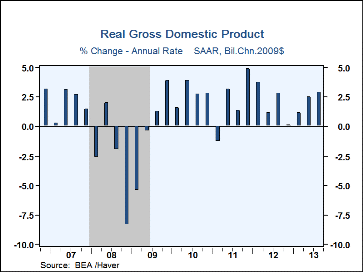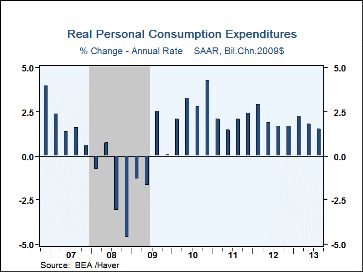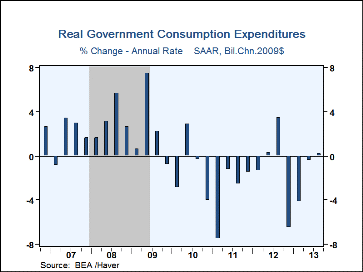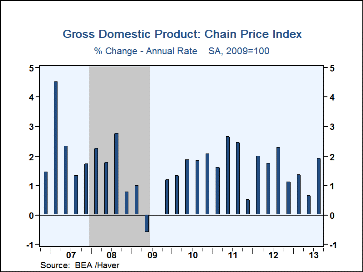 Global| Nov 07 2013
Global| Nov 07 2013U.S. GDP Growth Improves To A 2.8% Rate
by:Tom Moeller
|in:Economy in Brief
Summary
The pace of economic growth picked up last quarter. At 2.8% (AR, 1.6% y/y), Q3 growth in GDP followed a 2.5% advance in Q2. It was the firmest rise in four quarters and beat expectations for 2.0% in the Action Economics Forecast [...]
The pace of economic growth picked up last quarter. At 2.8% (AR, 1.6% y/y), Q3 growth in GDP followed a 2.5% advance in Q2. It was the firmest rise in four quarters and beat expectations for 2.0% in the Action Economics Forecast Survey.
A faster rate of inventory accumulation powered growth last quarter. Inventory accumulation added 0.8 percentage points to the Q3 GDP increase, double the contribution in Q2. During the last year, however, inventories had a neutral effect on GDP growth. Improvement in the foreign trade deficit also helped growth. The 0.3 percentage points contributed by trade was the most since Q4'12. It was the result of a 4.6% rise (3.0% y/y) in exports which outpaced 1.8% growth (1.5% y/y) in imports.
Growth in domestic final sales decelerated modestly to 1.7% and that pulled the y/y gain down to 1.4%, its weakest rise since early 2010. The deceleration owed to a 1.5% rise (1.8% y/y) in personal consumption expenditures, its weakest in just over two years. Weaker growth in spending on services of 0.1% (0.9% y/y) accounted for the slowdown. Spending on durable goods picked up to 7.9% (7.6% y/y) while nondurable goods spending rose a faster 2.7% (1.9% y/y).
Business fixed investment growth decelerated to 1.6% (2.7% y/y). Spending on equipment dropped at a 3.7% rate (+2.4% y/y) as a 17.5% jump (5.5% y/y) in industrial equipment was countered by a 3.9% decline (+5.3% y/y) in spending on information processing equipment. Spending on nonresidential structures surged at a 12.3% rate (3.6% y/y). Growth in residential investment remained near its peak at 14.6% (15.3% y/y).
In the government sector, a 0.2% advance (-2.8% y/y) was the first positive posting in a year. It resulted from a 1.5% rise (-0.1% y/y) in state & local outlays offset by a 1.7% decline (-6.5% y/y) in federal spending. Nondefense federal spending fell at a 3.4% rate (-2.3% y/y) which approximated the declines of the prior two quarters. Defense spending slipped at a 0.7% rate (-9.0% y/y).
The GDP price index rose at a 1.9% rate (1.3% y/y), the quickest quarterly growth in a year. Strength centered on a diminished 3.0% advance (4.6% y/y) in residential investment prices and a 1.9% gain (1.1% y/y) gain in consumer prices. Consumer prices excluding food & energy rose at a 1.4% rate (1.2% y/y). The business fixed investment price index rose at a 1.1% rate (1.1% y/y).
The latest GDP figures can be found in Haver's USECON and USNA databases; USNA contains basically all of the Bureau of Economic Analysis' detail in the national accounts, including the new integrated economics accounts and the recently added GDP data for U.S. Territories. The Action Economics consensus estimates can be found in AS1REPNA.
| Chained 2009 $, %, AR | Q3'13 (Preliminary) | Q2'13 | Q1'13 | Q3 Y/Y | 2012 | 2011 | 2010 |
|---|---|---|---|---|---|---|---|
| Gross Domestic Product | 2.8 | 2.5 | 1.1 | 1.6 | 2.8 | 1.8 | 2.5 |
| Inventory Effect | 0.8 | 0.4 | 0.9 | 0.0 | 0.2 | -0.2 | 1.5 |
| Final Sales | 2.0 | 2.1 | 0.2 | 1.6 | 2.6 | 2.0 | 1.0 |
| Foreign Trade Effect | 0.3 | -0.1 | -0.3 | 0.2 | 0.2 | 0.2 | -0.5 |
| Domestic Final Sales | 1.7 | 2.1 | 0.5 | 1.4 | 2.4 | 1.8 | 1.5 |
| Demand Components | |||||||
| Personal Consumption | 1.5 | 1.8 | 2.3 | 1.8 | 2.2 | 2.5 | 2.0 |
| Business Fixed Investment | 1.6 | 4.7 | -4.6 | 2.7 | 7.3 | 7.6 | 2.5 |
| Residential Investment | 14.6 | 14.2 | 12.5 | 15.3 | 12.9 | 0.5 | -2.5 |
| Government Spending | 0.2 | -0.4 | -4.2 | -2.8 | -1.0 | -3.2 | 0.1 |
| Chain-Type Price Index | |||||||
| GDP | 1.9 | 0.6 | 1.3 | 1.3 | 1.7 | 2.0 | 1.2 |
| Personal Consumption | 1.9 | -0.1 | 1.1 | 1.1 | 1.8 | 2.4 | 1.7 |
| Less Food/Energy | 1.4 | 0.6 | 1.4 | 1.2 | 1.8 | 1.4 | 1.3 |
Tom Moeller
AuthorMore in Author Profile »Prior to joining Haver Analytics in 2000, Mr. Moeller worked as the Economist at Chancellor Capital Management from 1985 to 1999. There, he developed comprehensive economic forecasts and interpreted economic data for equity and fixed income portfolio managers. Also at Chancellor, Mr. Moeller worked as an equity analyst and was responsible for researching and rating companies in the economically sensitive automobile and housing industries for investment in Chancellor’s equity portfolio. Prior to joining Chancellor, Mr. Moeller was an Economist at Citibank from 1979 to 1984. He also analyzed pricing behavior in the metals industry for the Council on Wage and Price Stability in Washington, D.C. In 1999, Mr. Moeller received the award for most accurate forecast from the Forecasters' Club of New York. From 1990 to 1992 he was President of the New York Association for Business Economists. Mr. Moeller earned an M.B.A. in Finance from Fordham University, where he graduated in 1987. He holds a Bachelor of Arts in Economics from George Washington University.












